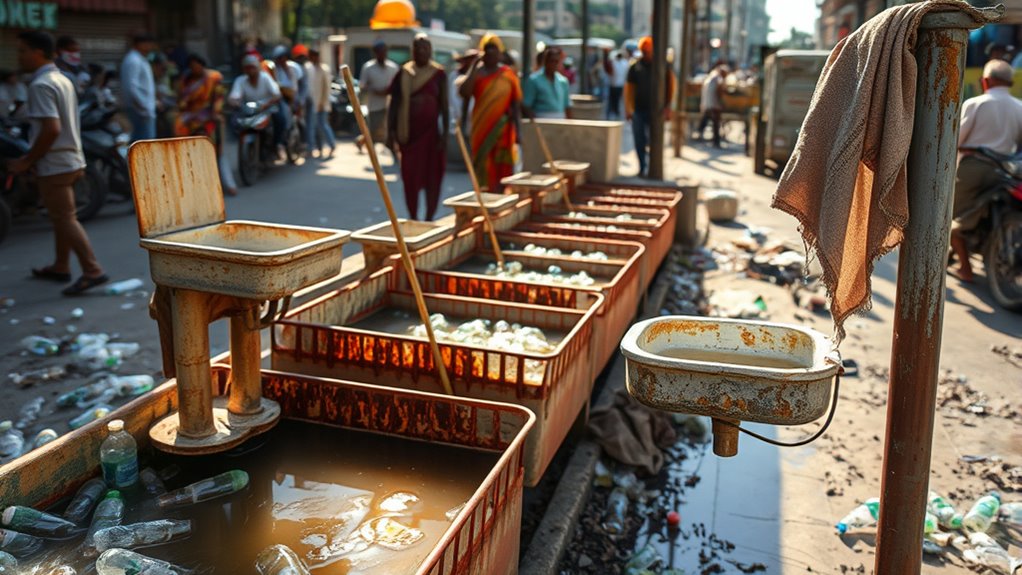When sanitation systems fail, you face health risks from contaminated water, foul odors, and rapid disease spread. Waste accumulates quickly, attracting pests and spreading germs that can cause illnesses like cholera and typhoid. Without proper disposal, hygiene becomes impossible, making outbreaks more likely. Short-term solutions include community efforts and emergency measures, but restoring infrastructure is key for long-term safety. Keep exploring to learn more about protecting yourself and your community during such crises.
Key Takeaways
- Implement temporary waste disposal methods like buckets or designated open areas to prevent accumulation and odor.
- Promote community-led sanitation efforts, including building makeshift latrines and organizing cleanup activities.
- Ensure access to clean water and handwashing facilities using purification tablets or boiling to reduce disease spread.
- Distribute hygiene supplies such as soap and disinfectants to maintain personal and environmental cleanliness.
- Prioritize restoring core sanitation infrastructure and educate communities on safe hygiene practices during crises.

What happens to sanitation when essential systems break down? When the infrastructure that keeps our environment clean fails, chaos quickly follows. Waste accumulates rapidly, and without proper disposal, it becomes a breeding ground for germs and disease. You might notice foul odors filling the air, making the surroundings uncomfortable and unhealthy. Water sources become contaminated as sewage leaks into rivers, lakes, or wells, spreading pathogens that threaten your health and that of your community. Without functioning sanitation systems, everyday hygiene practices become impossible, increasing the risk of infections like cholera, dysentery, and typhoid. These illnesses spread swiftly in such conditions, especially when clean water and proper waste disposal are absent.
When sanitation systems fail, waste spreads disease, foul odors fill the air, and communities face health crises.
In the absence of reliable sanitation, you’re forced to adapt quickly. You may resort to makeshift methods to manage waste, such as using buckets or open areas, but these solutions often fall short. They can lead to further contamination, attracting pests like rats and flies that carry disease. Without proper cleaning routines, bacteria and viruses linger on surfaces, increasing your chances of falling ill. In densely populated areas, the problem worsens because waste isn’t contained or properly managed, spreading disease more rapidly. The spread of illness isn’t just a personal risk; it can overwhelm local health services, leading to outbreaks that threaten entire communities.
Maintaining hygiene becomes a constant challenge. You need to find safe ways to dispose of waste, often relying on community efforts or emergency services. Handwashing, a simple yet essential defense against disease, becomes difficult without clean water and soap. As waste piles up, sanitation workers’ safety also becomes a concern, since they are exposed to hazardous materials and disease vectors. Without their work, the problem escalates, creating a vicious cycle of contamination and illness. People may even be forced to abandon their homes or move to crowded, unsanitary shelters where disease spreads unchecked. This displacement only worsens the health crisis, making recovery more difficult.
Additionally, proper waste management is fundamental in controlling disease transmission during sanitation failures. In these dire circumstances, community cooperation and resourcefulness are vital. You might see neighbors sharing water, building temporary latrines, or organizing cleanup efforts. Emergency measures, like distributing water purification tablets or setting up mobile sanitation stations, can help curb the spread of disease temporarily. Yet, without restoring full sanitation services, these are only band-aids. Long-term solutions require infrastructure repair, investment, and community education to prevent future breakdowns. Until then, your health depends on your ability to adapt, stay vigilant, and prioritize hygiene amid the chaos.
Frequently Asked Questions
How Can I Prevent System Failures in Sanitation Infrastructure?
You can prevent sanitation system failures by performing regular maintenance, inspections, and timely repairs. Keep components clean and free of debris, and guarantee proper training for staff to handle equipment correctly. Implementing preventive measures and monitoring systems helps identify potential issues before they escalate. Additionally, invest in durable infrastructure and stay updated on best practices to maintain a reliable, functional sanitation system that minimizes risks of failure.
What Are Quick Emergency Steps During Sanitation System Collapse?
If your sanitation system collapses, you should quickly isolate the affected area to prevent contamination. Use bottled water or boiled water for drinking and sanitation needs. Cover open waste to avoid spreading disease. If possible, set up temporary handwashing stations with soap and clean water. Contact local authorities or sanitation services immediately for professional assistance. These steps help minimize health risks until permanent repairs are completed.
Which Disinfectants Are Most Effective in Crisis Sanitation Situations?
In crisis sanitation situations, you should use disinfectants like bleach (sodium hypochlorite) at a 0.5% concentration, which is highly effective against bacteria and viruses. You can also consider chlorine dioxide or hydrogen peroxide-based solutions for their broad-spectrum efficacy. Confirm proper dilution and contact time, typically at least 10 minutes, to maximize disinfection. Always wear protective gear and follow safety guidelines to prevent harm during application.
How Do Sanitation Failures Impact Long-Term Public Health?
When systems fail, you’re playing with fire, risking long-term public health. These failures can lead to the spread of infectious diseases, increase healthcare costs, and erode community trust. If sanitation isn’t maintained, bacteria and viruses can become entrenched, causing persistent health issues. This cycle can be hard to break, ultimately compromising the well-being of entire populations and making recovery more difficult over time.
What Community Resources Are Available During Sanitation Emergencies?
During sanitation emergencies, you can access local health departments, emergency response teams, and community centers for assistance. These resources often provide clean water supplies, sanitation supplies like disinfectants, and health advice. Nonprofit organizations and volunteers also step in to distribute hygiene kits and educate residents on safe practices. Stay informed through official alerts and don’t hesitate to reach out to these community resources to protect yourself and others.
Conclusion
When systems fail, your role in maintaining sanitation becomes more vital than ever. Imagine a community where water treatment plants break down, and residents take proactive steps—like boiling water and using portable sanitation solutions—to prevent disease. By staying vigilant and adaptable, you can protect yourself and others from outbreaks. Remember, even in challenging times, your quick actions and hygiene practices can make all the difference in keeping your environment safe and disease-free.










